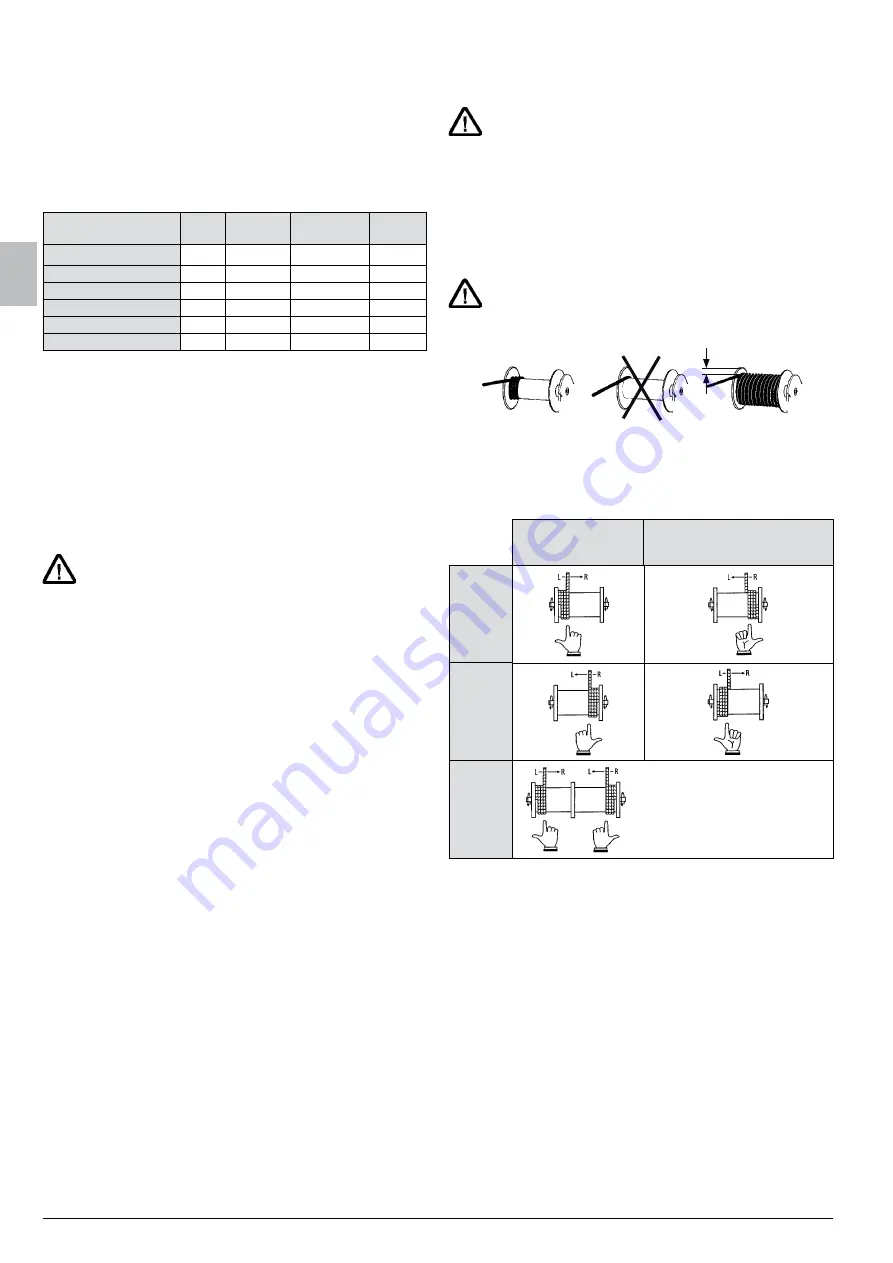
094278_t_de_gb_fr_es_it_pt_eseilwi_s
haacon hebetechnik gmbh – T49 (0) 9375 - 84-0 – Fax +49 (0) 9375 - 84-66
22
4. InSTAllATIOn
The safety instructions (Chapter 2) apply, in particular for sto-
rage, transport and assembly (Chapter 2.4).
4.1 mounting
– Connection construction: sufficient strength and rigidity, in
order to safely accommodate occurring forces.
– Contact surface even, for tension-free attachment.
– Use screws, which do not loosen themselves.
Screwing specifications:
TYPE
Dim. Strength Tightening
torque [nm] number
ESF 150 / 200 / 250
M8
8.8
25
≥ 4
ESF 400 / 500
M10
8.8
50
≥ 4
ESG 150 / 200 / 250
M8
8.8
25
≥ 4
ESG 400 / 500
M10
8.8
50
≥ 4
ESG 700 / 750 / 990
M12
8.8
87
≥ 5
ESG 1100 / 1500 / 2100
M16
8.8
210
≥ 5
4.2 Installation Position, Gear Venting
z
Replace a plug screw by the provided vent screw depending
on the installation position after mounting the rope winch.
z
Turn the connection cover on the gear in such a way that the
vent point upwards for winches type ESF as well as for the
types ESG 150/200/250/400 and 500.
Rope winches of load class over 600 kg are also supplied
without oil filling, if specifically required.
Installation position
B3 applies, if no installation position has been specified
.
If the operator changes in the assembly position, check the oil
level and if necessary adapt before operation.
The installation position of the winch is determined by the
position of the gear. Therefore, the position of the vent,
oil inspection, as well as oil filling amount varies
(–> Appendix A and user operating instructions of the
manufacturer).
The correct installation position is a precondition for
safe operation and must be observed.
Installation position B6 and B7 (drum shaft vertical)
are inadmissible, since safe winding of the rope is not
ensured.
Allocation gear to winch –> Spare parts lists.
4.3 Ropes
4.3.1 General notes
– Select a rope suitable for your purposes.
The EN 12385-3 e.g. provides selection aids.
Wire ropes differ by:
– their design/construction. (twist-free, low-twist and non-
twist-free rope). haacon recommends rope types 6x19M or
7x19 (not twist-free) and the type 17x7 (low-twist) according
to EN 12385.
– the strength of the it individual strands. The minimum tensile
strength of the rope results from this (–> technical data /
type plate).
– The rope diameter (–> technical data / type plate).
– The impact direction. haacon recommends the use of right-
handed ropes (Designation Z). Their use is obligatory with
grooved drums.
– The surface. Only use galvanized or high-grade steel wire
rope outdoors.
Instructions for use:
– One-stranded operation and non-guided loads:
Low-twist or twist-free ropes.
– Multi-layer coiling: Rope with steel core.
– Rope ends: safeguard against unsplicing.
– Lubrication extends the service life.
Not permissible:
–
using rope made of other material than steel, as well
as plastic casing
–
corrosion, damage, or strong contamination.
4.3.2 Rope Attachment to the Drum
z
Lead rope out through the opening of the flanged wheel.
z
Position under the rope clamp slightly projecting and tighten.
Attach rope in such a way that it winds up unhampered
onto the rotating drum. Kinking or leading across edges
is prohibited. If the drum is marked with an arrow, then
this indicates the drum rotation direction which must be
observed when winding up the rope.
4.3.3 Rope course
Arrange cable drives in such a way that ropes cannot be da-
maged by contacting each other or by touching immobile and
moving constructions. The rope must be wound up evenly
and tautly.
Wind up the wire rope under pretension, e.g. fully wind
up the rope and adjust the rope length to the lift.
The rope length is correct, if:
> 3
> 1,5 x rope-Ø
Single-pass winding drums must be furnished with grooves.
The rope coiling direction is correct, if:
A) Right-handed rope = left-handed drum = standard
= Required with grooved drum
B) Left-handed rope = right-handed drum = exception
I
Rotation direction of
the drum: right
II
Rotation direction of the
drum: left
A
B
A left and a right-handed rope
should be preferentially used
on a divided drum.
GB



































